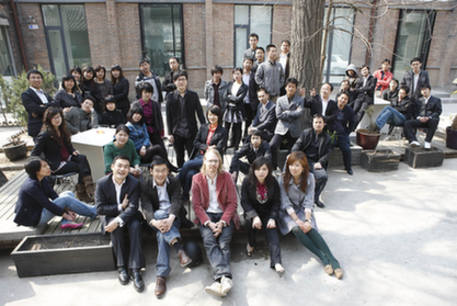| From Factory Floor to Design Headquarters
 |
|
The youthful designer team of LKK. Wang Zhi |
AN iPhone made by a Chinese OEM (original equipment manufacturer) sells for US $499 in the US market, while the commissioned Chinese manufacturer of the phone gets a recompense of only US $4. Such humble returns characterize the so-called profits of Chinese manufacturers and leave little means for their survival and growth. The upside is that the nation's manufacturers are under pressure to develop their own technologies and brand names. Design is the skill sector needed to improve China's economic clout.
As the Chinese manufacturing industry transforms from a "China-made" to a "China-created" identity, industrial design is becoming one of the most dynamic and promising sectors in Beijing's creative economy. Success in developing this capability will definitely change China's stereotypical role as the workshop of the world. The Chinese government has classified industrial design as a sector of the modern service industry and is promoting the profession as part of a national strategy to upgrade and elevate the country's economic structure.
In June 2005 the Beijing Municipal Science and Technology Commission and the Xicheng District government joined hands to build a 2,500-square-meter industrial design platform and a 5,500-square-meter industrial design incubator on the former site of a telephone equipment factory in central Beijing. The child they conceived and delivered has now grown into the famous Beijing DRC Industrial Innovation Base, an ongoing experiment in industrial design resource integration and collaboration.
Its concept is to optimize innovative resources and assemble a critical mass of design professionals. "To economize on scarce resources you must step up their management. To make the most of available industrial design resources the DRC Base creates the convergence of practioners and businesses necessary for sharing and optimal utilization, thereby promoting the development of the profession in China," says Chen Dongliang, executive director of the China Industrial Design Association and director of the Beijing Industrial Design Center.
The DRC leaves no stone unturned where its services are concerned. It helps its members jump through the hoops of high- and new-tech certification, provides innovation funds for small and medium-sized businesses, assists them in applying for government-subsidized design-related innovation and upgrading projects, and sponsors exhibitions, forums and promotional activities to support professional community-building. These services form a congenial incubation environment for enterprises within the base and enhance the operating capability of its small and medium-sized members. Currently 200 plus enterprises are here, engaged in the design of products, graphics, architectural environments, engineering, fashions and providing related consultation services.
First through the door of DRC in January 2006, when construction was barely complete, was Beijing Sense Industrial Design Co., Ltd. (Sense Design). Here the fledging company completed their designs for transnational companies such as Haier and Panasonic. Over its first five years in business its assets have quintupled. The gardening-tool kit it designed has generated a US $100-million overseas market for the client that commissioned it. Han Yongli, founder of Sense Design, was fresh out of university when he started the company. The DRC's advanced concept and incubation platform helped him realize his entrepreneurial dream.
LKK also entered the DRC in early 2006, and within three years grew quickly from a small design house into Beijing's largest industrial design company and one of China's best. It partnered with Samsung to design automatic ticket machines for Beijing's subway Line 4, Line 10 and Olympic Link, and is the global design service provider for seven of the world's top 500 companies, including Nokia, Samsung and PetroChina. The company has received several national and international awards, including the famous Red Dot and IF design awards based in Germany, and the Red Star, China's highest industrial design award. Its annual business has snowballed from six digits in 2006 to the current RMB 20 million. LKK has opened new branches in Shenzhen and London.
| 